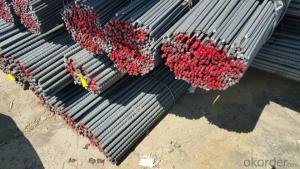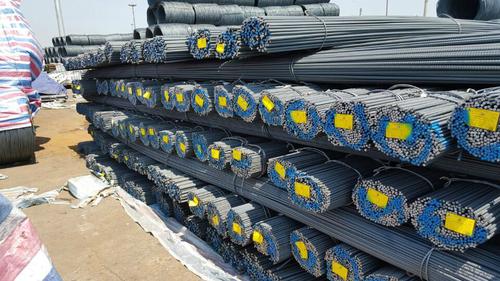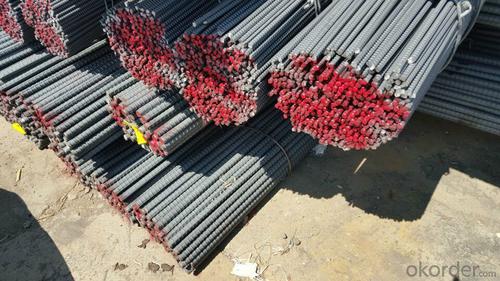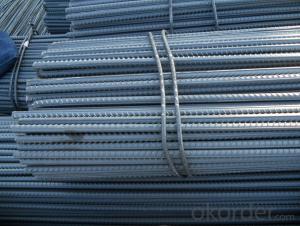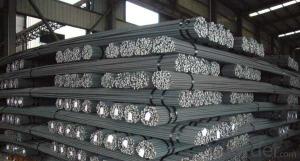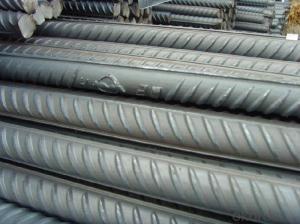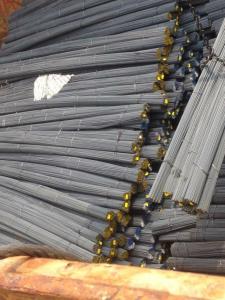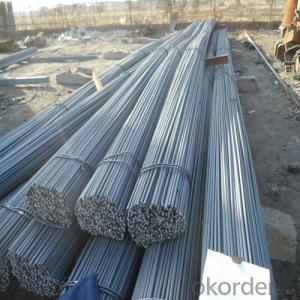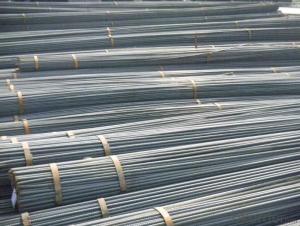HRB400 Deformed Steel Bar,Reinforced Deformed Steel Bar
- Loading Port:
- Tianjin
- Payment Terms:
- TT OR LC
- Min Order Qty:
- 30 m.t.
- Supply Capability:
- 100000 m.t./month
OKorder Service Pledge
OKorder Financial Service
You Might Also Like
Specification
Product Description:
Specifications of HRB400 Deformed Steel Bar,Reinforced Deformed Steel Bar
Standard | GB | HRB400 | |
Diameter | 6mm,8mm,10mm,12mm,14mm,16mm,18mm,20mm, 22mm,25mm,28mm,32mm,36mm,40mm,50mm | ||
Length | 6M, 9M,12M or as required | ||
Place of origin | Hebei, China mainland | ||
Advantages | exact size, regular package, chemical and mechanical properties are stable. | ||
Type | Hot rolled deformed steel bar | ||
Chemical Composition of HRB400 Deformed Steel Bar,Reinforced Deformed Steel Bar
Grade | Technical data of the original chemical composition (%) | ||||||
C | Mn | Si | S | P | V | ||
HRB400 | ≤0.25 | ≤1.60 | ≤0.80 | ≤0.045 | ≤0.045 | 0.04-0.12 | |
Physical capability | |||||||
Yield Strength (N/cm²) | Tensile Strength (N/cm²) | Elongation (%) | |||||
≥400 | ≥570 | ≥14 | |||||
Usage and Applications of HRB400 Deformed Steel Bar,Reinforced Deformed Steel Bar
Deformed bar is widely used in buildings, bridges, roads and other engineering construction. Big to highways, railways, bridges, culverts, tunnels, public facilities such as flood control, dam, small to housing construction, beam, column, wall and the foundation of the plate, deformed bar is an integral structure material. With the development of world economy and the vigorous development of infrastructure construction, real estate, the demand for deformed bar will be larger and larger..
Packaging & Delivery of HRB400 Deformed Steel Bar,Reinforced Deformed Steel Bar
Packaging Detail: products are packed in bundle and then shipped by container or bulk vessel, deformed bar is usually naked strapping delivery, when storing, please pay attention to moisture proof. The performance of rust will produce adverse effect.
Each bundle weight: 2-3MT, or as required
Payment term: TT or L/C
Delivery Detail: within 45 days after received advanced payment or LC.
Label: to be specified by customer, generally, each bundle has 1-2 labels
Trade terms: FOB, CFR, CIF
Images of HRB400 Deformed Steel Bar,Reinforced Deformed Steel Bar
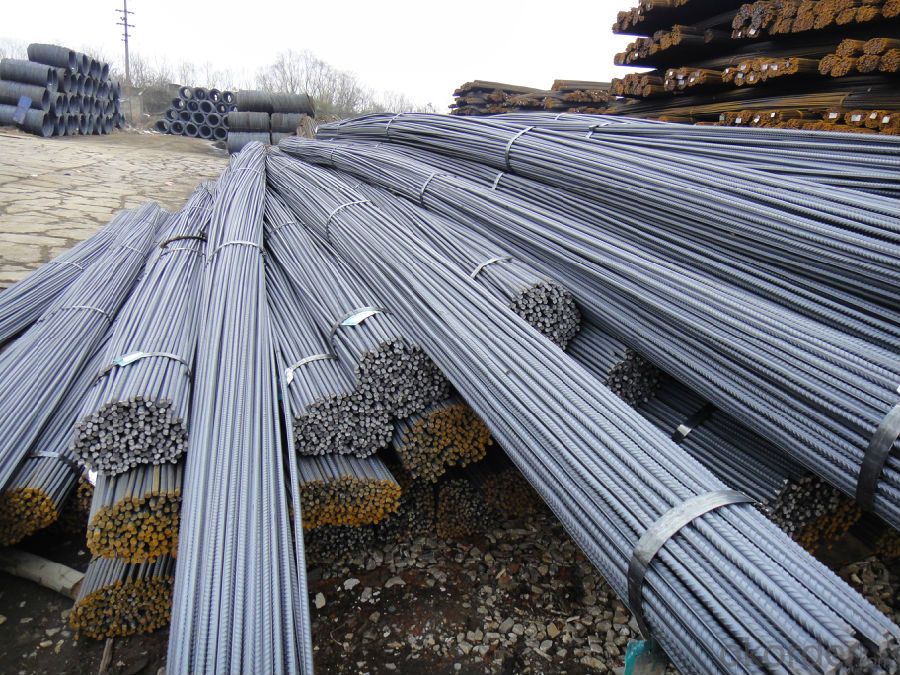
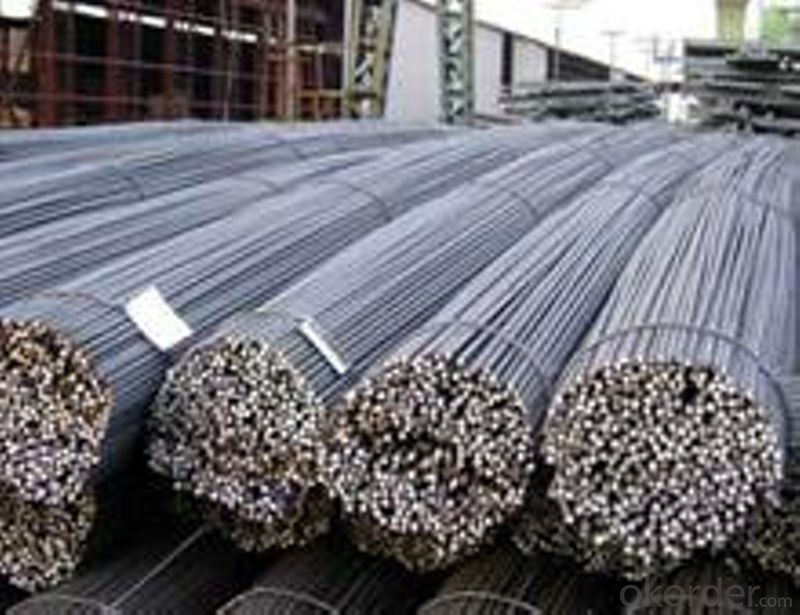
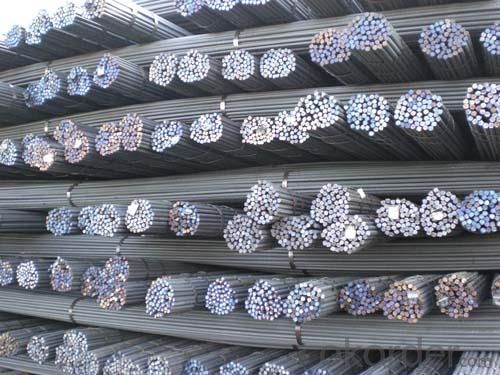
- Q: What is the role of steel rebars in increasing the load-carrying capacity of a structure?
- Steel rebars play a crucial role in increasing the load-carrying capacity of a structure. They are used as reinforcement in concrete structures to enhance their strength and durability. Rebars are typically made of carbon steel and are designed to withstand tension forces in the structure. When concrete is subjected to heavy loads or external forces, it tends to crack or deform. Steel rebars are placed strategically within the concrete to counteract these forces and prevent the formation of cracks. By distributing the load across a wider area, rebars help in improving the structural integrity of the entire system. The interlocking nature of rebars with the surrounding concrete also allows for the transfer of stresses between the two materials. This ensures that the load is evenly distributed throughout the structure, reducing the chances of localized failures or collapses. Moreover, steel rebars provide additional tensile strength to the concrete, which is otherwise weak in tension. Concrete is strong in compression but relatively weak in tension, and the introduction of rebars helps to counterbalance this weakness. The rebars act as a reinforcement framework, absorbing the tensile forces and preventing the concrete from cracking or failing under excessive loads. In summary, the role of steel rebars in increasing the load-carrying capacity of a structure is to provide reinforcement, distribute loads, prevent cracks, enhance structural integrity, and counterbalance the weakness of concrete in tension. By incorporating rebars, engineers can design and construct safer and more robust structures capable of withstanding greater loads and external forces.
- Q: How are steel rebars used in parking structures?
- Steel rebars are used in parking structures to reinforce and strengthen the concrete, increasing its load-bearing capacity and durability. They are typically placed in the concrete to resist tension and prevent cracking, ensuring the structure's stability and longevity.
- Q: What are the factors that can affect the lifespan of steel rebars in concrete structures?
- There are several factors that can affect the lifespan of steel rebars in concrete structures. These factors include the quality of the steel used, the level of corrosion protection provided, the exposure to harsh environmental conditions, the presence of cracks or voids in the concrete, and the maintenance and repair practices followed.
- Q: How do steel rebars affect the maintenance requirements of a structure?
- The maintenance requirements of a structure are significantly influenced by steel rebars, also known as reinforcing bars. These bars, which are constructed from steel, are embedded in concrete to provide strength and durability to the structure. Enhancing the overall structural integrity of a building or infrastructure is one of the primary ways in which steel rebars impact maintenance. The presence of rebars greatly increases the load-bearing capacity of concrete, enabling it to withstand external forces such as wind, earthquakes, and heavy loads. This reinforcement helps to prevent cracks, deformations, and structural failures, ultimately reducing the maintenance needs of a structure. Moreover, steel rebars also contribute to the longevity of a structure. By offering tensile strength to concrete, they shield it from the negative effects of shrinkage and expansion caused by temperature fluctuations. These rebars act as a framework that holds the concrete together, minimizing the risk of cracks and ensuring the structural stability of the building over time. As a result, the maintenance requirements are reduced as the structure remains intact and resilient against environmental factors. Nevertheless, it is important to acknowledge that steel rebars can also impact maintenance requirements in specific situations. If the rebars are not designed, installed, or protected properly, they can be vulnerable to corrosion. Corrosion occurs when moisture and oxygen penetrate the concrete and reach the steel, causing it to rust. Rusting rebars can lead to the expansion of steel, creating internal pressure that can result in cracking and spalling of the concrete. Consequently, regular inspections, maintenance, and protection measures such as epoxy coating or cathodic protection systems are necessary to prevent corrosion and ensure the longevity of the structure. In conclusion, steel rebars have a positive impact on the maintenance requirements of a structure by enhancing its strength, durability, and longevity. They decrease the need for repairs and maintenance caused by structural failures and increase the overall resilience against external forces. However, proper design, installation, and protection of rebars are crucial to avoid corrosion-related issues that could increase maintenance needs.
- Q: Can steel rebars be used in seismic-resistant structures?
- Yes, steel rebars can be used in seismic-resistant structures. Steel rebars have excellent tensile strength and ductility, making them an ideal reinforcement material for concrete structures in earthquake-prone areas. When properly designed and installed, steel rebars can help increase the structural integrity and resistance of buildings to seismic forces. They provide additional strength and flexibility to the concrete, allowing it to better withstand the lateral and vertical loads exerted during an earthquake. Moreover, steel rebars can effectively dissipate and absorb the energy generated during seismic events, reducing the potential for structural damage or collapse.
- Q: Can steel rebars be used in structures with high aesthetic requirements?
- Yes, steel rebars can be used in structures with high aesthetic requirements. While rebars are primarily used for their structural strength and reinforcement purposes, they can also be incorporated into architectural designs to enhance the visual appeal of a structure. With various surface finishes and coatings available, steel rebars can be customized to meet specific aesthetic requirements, ensuring they blend seamlessly with the overall design and aesthetics of the structure.
- Q: Are there any specific guidelines for storing steel rebars on-site?
- Yes, there are specific guidelines for storing steel rebars on-site. These guidelines typically include keeping the rebars off the ground using racks or pallets, ensuring proper alignment and support to prevent bending or warping, protecting them from moisture and corrosion by covering with waterproof material, and organizing them in a way that allows easy access and identification. It is also important to follow any manufacturer recommendations and local building codes for safe storage of steel rebars.
- Q: Can steel rebars be used in aggressive chemical environments?
- Steel rebars can be used in aggressive chemical environments to some extent. However, their performance may be compromised depending on the severity and nature of the chemicals present. Steel rebars are generally resistant to mild to moderate chemical exposures, such as those found in most construction applications. However, in highly aggressive chemical environments, where exposure to corrosive substances like acids, alkalis, or salts is prolonged and intense, steel rebars may corrode and deteriorate over time. In such cases, alternative materials like stainless steel rebars or epoxy-coated rebars may be more suitable, as they provide enhanced resistance to corrosion in aggressive chemical environments. It is important to consider the specific conditions of the chemical environment and consult with experts or structural engineers to determine the most appropriate rebar material for the given situation. Regular inspections and maintenance should also be conducted to monitor the condition of steel rebars and ensure their longevity in aggressive chemical environments.
- Q: What are the guidelines for handling and disposing of steel rebars after demolition?
- The guidelines for handling and disposing of steel rebars after demolition include the following: 1. Identification: It is important to identify the steel rebars and differentiate them from other construction debris. This can be done by marking or labeling the rebars appropriately. 2. Segregation: Separate the steel rebars from other waste materials on-site. This ensures that they can be properly handled and recycled or disposed of accordingly. 3. Demolition process: During the demolition process, care should be taken to minimize damage to the steel rebars. This includes using appropriate tools and techniques to avoid excessive bending or cutting, which can affect their recyclability. 4. Removal and transportation: After demolition, the steel rebars should be carefully removed from the site and transported to the designated area for further processing or disposal. This may involve the use of machinery or manual labor, depending on the quantity and size of the rebars. 5. Recycling: Steel rebars are highly recyclable and should be sent to a recycling facility whenever possible. These facilities can process the rebars and convert them into new steel products, reducing the need for extracting and manufacturing new materials. 6. Disposal: If recycling is not feasible, the steel rebars may need to be disposed of in accordance with local regulations. This may involve taking them to a designated landfill or waste disposal site that can handle construction materials. 7. Safety precautions: It is important to follow safety precautions when handling steel rebars. This includes wearing appropriate personal protective equipment (PPE) such as gloves and safety glasses, as well as using proper lifting techniques to prevent injuries. 8. Compliance with regulations: Ensure that all handling and disposal activities comply with local, state, and federal regulations. This may include obtaining necessary permits or licenses, as well as adhering to specific guidelines for waste management and recycling. By following these guidelines, the handling and disposal of steel rebars after demolition can be done in an environmentally responsible and safe manner, contributing to sustainable construction practices.
- Q: What is the process of removing rust from steel rebars?
- There are several steps involved in the process of removing rust from steel rebars. Firstly, inspect and assess the rust damage on the rebars. Determine whether the rust is superficial or deeply penetrated and evaluate the overall structural integrity. Before starting the rust removal process, ensure that you have the appropriate personal protective equipment (PPE) on, such as gloves, goggles, and a respirator. This is necessary to protect yourself from any harmful chemicals or debris that may be generated. To clean the surface of the rusted rebars, use a wire brush or a grinder with a brush attachment. This will help remove loose rust, dirt, and other debris. Make sure to thoroughly clean the surface before proceeding. Apply a rust converter or rust remover solution to the rusted areas of the rebar. These solutions contain chemicals that react with the rust, either converting it into a stable compound or dissolving it completely. Follow the manufacturer's instructions for the specific product being used. If the rust has not completely dissolved or converted after the chemical treatment, mechanical methods may be required. This can involve sanding the surface with sandpaper or using a wire brush to scrub off the remaining rust. Once the rust has been removed, rinse the rebars thoroughly with clean water to remove any residual chemicals or debris. Allow the rebars to dry completely before applying any further treatment or protective coatings. To prevent future rusting, it is important to apply a protective coating or paint to the rebars. This acts as a barrier against moisture and air, which are the main causes of rust formation. Choose a high-quality rust-resistant primer and paint specifically designed for steel reinforcement bars. It should be noted that removing rust from steel rebars requires expertise and adherence to safety precautions. In some cases, severe rust damage may require professional assistance or even replacement of the affected rebars.
Send your message to us
HRB400 Deformed Steel Bar,Reinforced Deformed Steel Bar
- Loading Port:
- Tianjin
- Payment Terms:
- TT OR LC
- Min Order Qty:
- 30 m.t.
- Supply Capability:
- 100000 m.t./month
OKorder Service Pledge
OKorder Financial Service
Similar products
Hot products
Hot Searches
Related keywords


